|
|
Reports
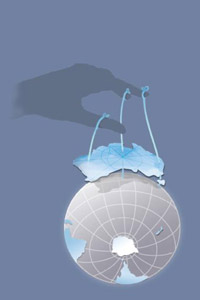 |
Balancing Act: A triple bottom line analysis of the Australian economy
The Balancing Act report is divided into four
volumes available for download as separate Adobe
Acrobat pdf files. You will need Adobe Acrobat
Reader to view the files.
Each volume is a large file and may be slow to
download across low bandwidth Internet connections.
If you have problems downloading or accessing the
files, please request the report on a CD ROM by emailing
the Resource Futures Program [email protected]
at CSIRO Sustainable Ecosystems. |
 |
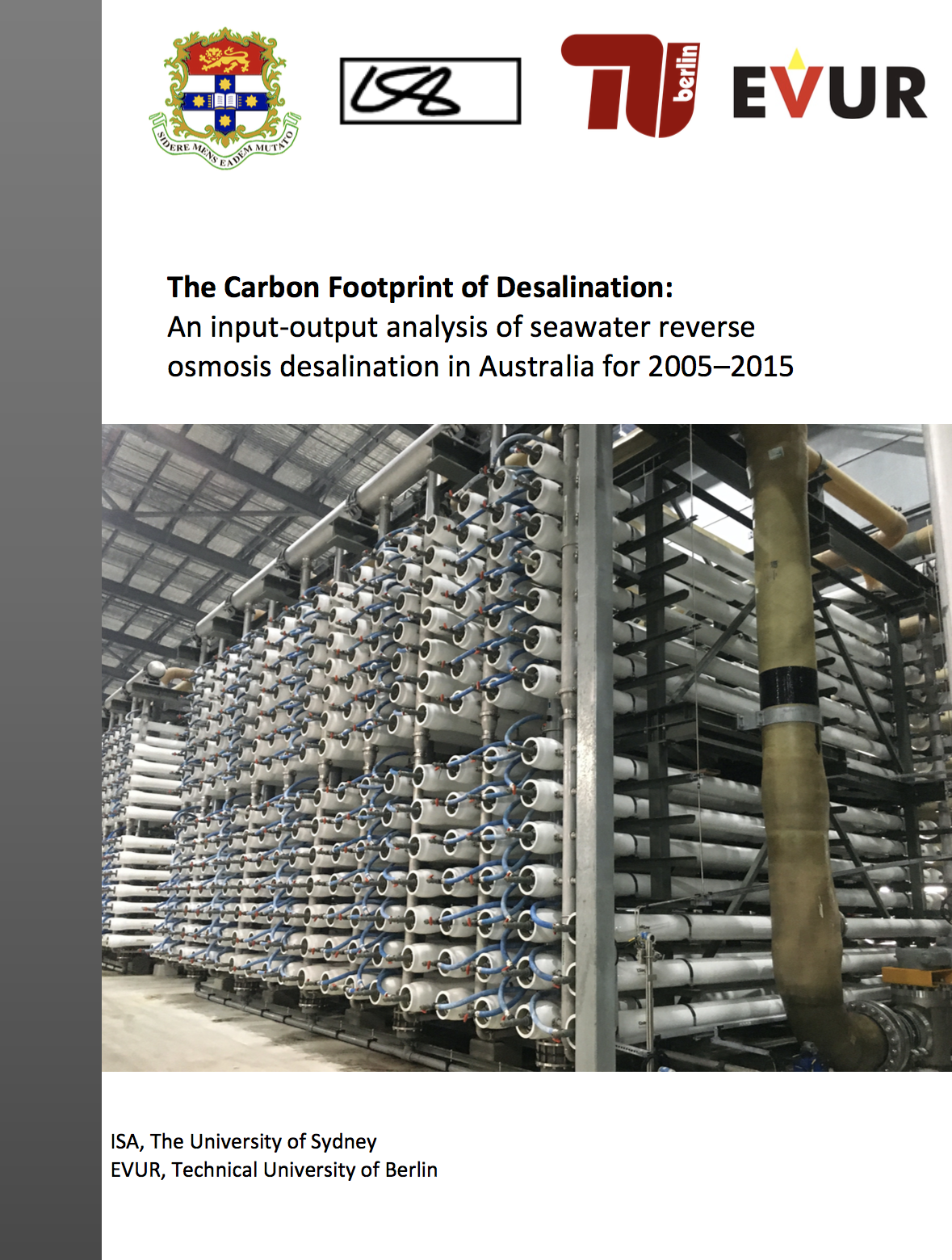
|
The Carbon Footprint of Desalination
This study examines greenhouse gas emissions for 2005-2015 from seawater desalination in Australia, using conventional energies. We developed a tailor-made multi-regional input-output-model. We complemented macroeconomic top-down data with plant-specific desalination data of the largest 20 desalination plants in Australia. The analysed capacity cumulates to 95% of Australia’s overall seawater desalination capacity. We considered the construction and the operation of desalination plants. We measure not only direct effects, but also indirect effects throughout the entire value chain. Our results show the following: We identify the state of Victoria with the highest emissions due to capital and operational expenditures (capex and opex). The contribution of the upstream value chain to total greenhouse gas emissions increases for capex and decreases for opex. For capex, the construction of intake and outfall is the driving factor for carbon emissions. For opex, electricity consumption is the decisive input factor. Both in construction and operation, we identify the critical role of the electricity sector for carbon emissions throughout the supply chain effects. The sector contributes 69% during the zenith of the construction phase and 96% during the operating phase to the entire emissions. We estimate the total emissions for 2015 at 1,193 kt CO2e. |
 |
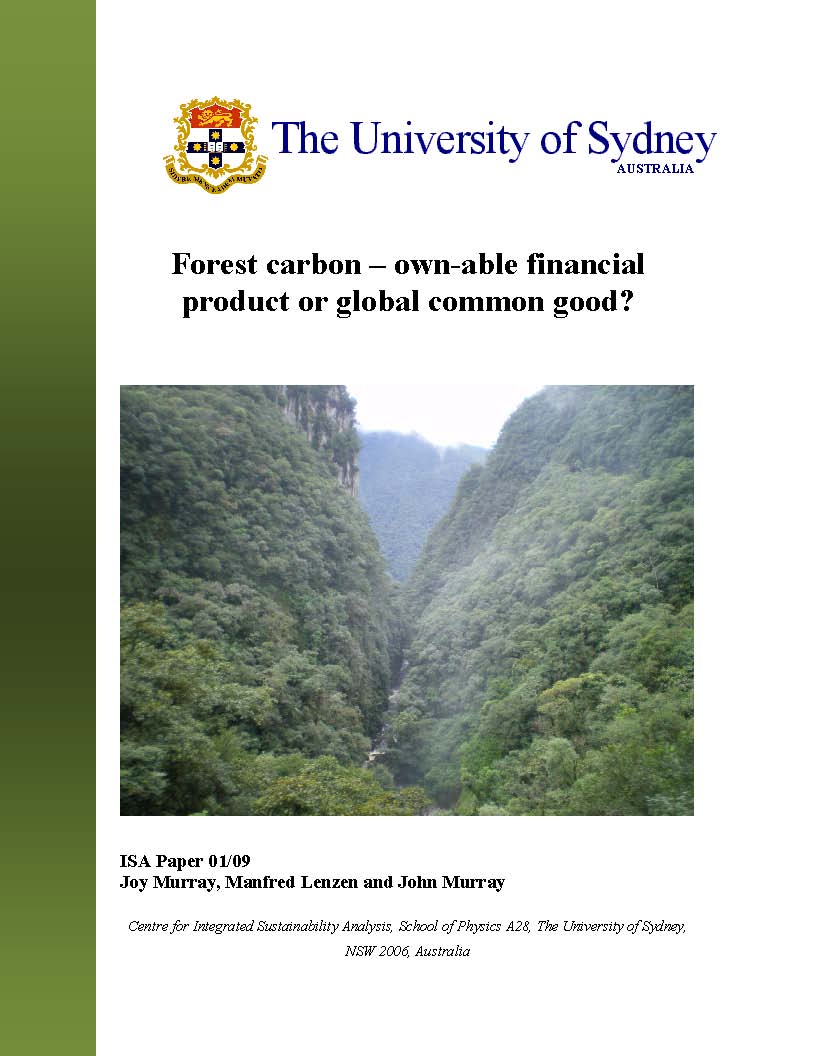
|
Forest carbon – own-able financial product or global common good?
With the debate linking greenhouse gases and climate change increasingly shifting from the science arena into policy and finance, a number of issues are emerging around carbon trading. Carbon sequestered in forests until recently was un-ownable. But who owns the carbon and who trades in what some are calling a new financial product, or a new form of money, are still highly contested questions. Allocation of ownership rights is hampering the transition of carbon from collectively owned ecosystem input to individually owned commodity. But should forest carbon become a financial product? This paper examines the issue of carbon sequestered in forests and the global mechanisms to exploit it. Some of the consequences of distinguishing the carbon from the tree and building a multi-million dollar enterprise around this distinction are discussed. Consequences include carbon crime and the rebound effect of wealth accumulating to the wealthy and spent on carbon intensive goods; and the possibility of funds flowing back into forest communities. It concludes with the divergent consequences of two alternatives for exploiting the world’s forests. |
 |
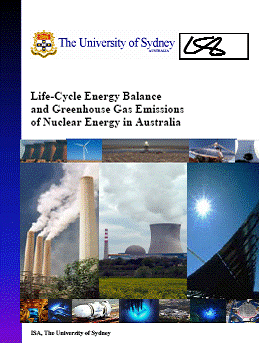 |
Life-cycle energy and greenhouse gas emissions of nuclear energy in Australia
The increased urgency of dealing with the mitigation of looming climate change has sparked renewed interest in the nuclear energy option. There exists a substantial stream of research on the amount of embodied energy and greenhouse gas emissions associated with nuclear-generated electricity. While conventional fossil-fuelled power plants cause emissions almost exclusively from the plant site, the majority of greenhouse gas emissions in the nuclear fuel cycle are caused in processing stages upstream and downstream from the plant. This paper distils the findings from a comprehensive literature review of energy and greenhouse gas emissions in the nuclear fuel cycle, and determines some of the causes for the widely varying results.
The most popular reactor types, LWR and HWR, need between 0.1 and 0.3 kWhth, and on average about 0.2 kWhth for every kWh of electricity generated. These energy intensities translate into greenhouse gas intensities for LWR and HWR of between 10 and 130 g CO2-e / kWhel, with an average of 65 g CO2-e / kWhel.
While these greenhouse gas are expectedly lower than those of fossil technologies (typically 600-1200 g CO2-e / kWhel), they are higher than reported figures for wind turbines and hydroelectricity (around 15-25 g CO2-e / kWhel), and in the order of, or slightly lower than solar photovoltaic or solar-thermal power (around 90 g CO2-e / kWhel). |
 |
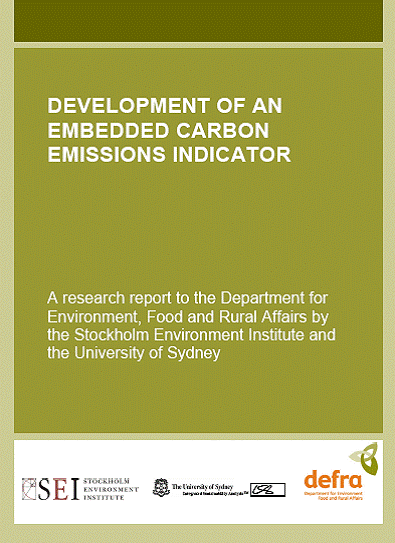 |
Embedded carbon in the consumption of the UK - the UK's carbon footprint
This report is the result of collaborative work between the Stockholm Environment Institute and ISA, commissioned by Defra UK.
It describes the development of a time series of input-output tables for the UK by using an automated data optimisation procedure that allows the construction of national input-output and environmental databases in greatest possible sector disaggregation, and that can be used for compiling multi-region environmental input-output models. Thus the work sets the basis for the routine calculation of carbon footprints for any country, enabling multi-regional analyses of environmental impacts associated with international trade flows, including the provision of a robust indicator for embedded emissions. The report has three parts: the Executive Summary, the main report, and a sensitivity and uncertainty calculation. |
 |
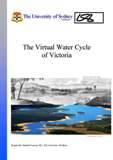 |
The Virtual Water Cycle of Victoria
This report defines and quantifies the virtual water Cycle for Victoria. Virtual water is the water embodied in all products and services consumed in Victoria, rather than merely the direct water used. An understanding of our virtual water use has the potential to provide significant water savings, and to affect water use beyond the boundaries of cities and regions over the longer term. In particular, this report enhances the understanding of the link between irrigation water use and the consumption of Victoria’s residents, and provides improved awareness that lifestyle and consumption in the urban setting has a direct affect on how water is used throughout the whole of Australia, and to reinforce the message that improved rural water management is not a problem for farmers alone to tackle. |
 |
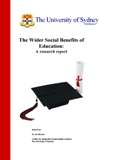 |
The Wider Social Benefits of Education
Business and Industry are recognising that the social outcomes of doing business underpin their social licence to operate. The ISO 26000, to be introduced in 2008, will provide guidance on Social Responsibility (SR) for all types of organisations in both public and private sectors. The Global Reporting Initiative includes numerous social indicators in its reporting framework (GRI, 2006). Business and industry seem to be moving towards taking responsibility for the social effects of doing business, recognising that their organisations are embedded in community. Meanwhile in the field of education there has been a major shift in Australia towards private expenditure in the tertiary sector (OECD, 2006) accompanied by a shift of public subsidies to tertiary students themselves. Implicit in this funding shift is the message that tertiary education is a private rather than public good, belonging to individual students rather than the wider population. This paper explores the literature on the wider social benefits of higher education, most of which seem to be indirect, arising through the increased economic benefits to individuals. It points to the gaps in Australian research in this area. |
 |
 |
The Ecological Footprint - Issues and Trends
The ecological footprint was originally conceived as a simple and elegant method for comparing the sustainability of resource use among different populations, and has since considerably enriched the sustainability debate. Since the formulation of the ecological footprint, a number of researchers have mentioned the oversimplification in ecological footprints of the complex task of measuring sustainability of consumption. In particular, aggregated forms of the final ecological footprint make it difficult to understand the specific reasons for the unsustainability of the consumption of a given population, and to formulate appropriate policy responses. In response to the issues highlighted, the Ecological Footprint has undergone significant modification. Comprehensive input-output-based ecological footprints are now calculated in many countries, and applied to populations, companies, cities, regions and nations. |
 |
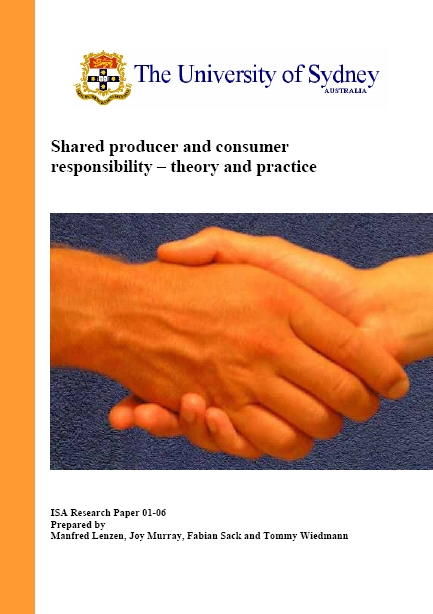 |
Shared Producer and Consumer Responsibility - Theory and Practice
Over the past decade, an increasing number of authors have been examining producer versus consumer responsibility. Recently, a problem has appeared in drafting the standards for the Ecological Footprint: While the method traditionally assumes a full life-cycle perspective with full consumer responsibility, a large number of producers have started to calculate their own footprints. Adding any producers footprint to population footprints that all already cover the full upstream supply chain, leads to double-counting: The sum over footprints of producers and consumers is larger than the total national footprint. The committee in charge of the Footprint standardisation process was faced with the decades-old non-additivity problem, posing the dilemma
of how to curtail the supply chains of actors in order to avoid double-counting. This report demonstrates a non-arbitrary method of consistently delineating these supply chains, into mutually exclusive and collectively exhaustive portions of responsibility to be shared by all actors in an economy.
|
 |
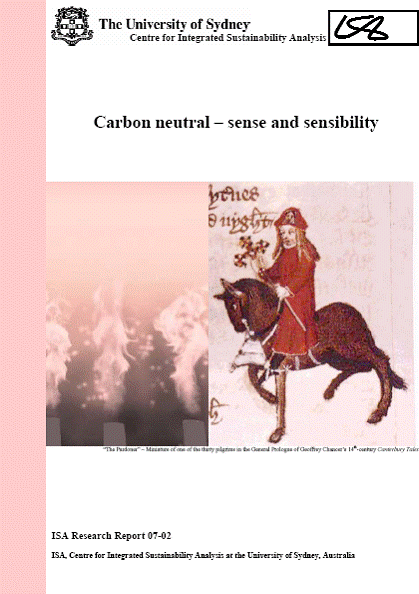 |
Carbon neutral - sense and sensibility
Businesses offering to make you or your company carbon neutral are proliferating on the internet. The term carbon neutral is being defined by common usage. There are no standard ways of measuring your carbon emissions and so no standards for becoming carbon neutral. This paper examines eleven websites offering carbon neutrality. It compares online calculators, their results and the costs of offsetting calculated on the strength of those results. It traces two offset projects from the online carbon offset retailer to the actual project on the ground in order to compare the online rhetoric with the time consuming and difficult work of developing community based projects in Third World countries. The paper offers a definition of carbon neutral based on the ways in which the term is being used. It also uncovers a range of issues for further discussion.
|
 |
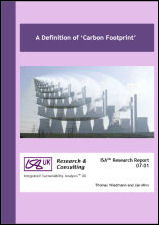 |
A definition of 'carbon footprint'
The term carbon footprint has become very popular over the last few years and is now in widespread public use. With climate change high up on the political and corporate agenda, carbon footprint assessments are in strong demand. Despite its ubiquitous public use however, the scientific literature is surprisingly void of clarifications, let alone definitions of the term 'carbon footprint'. This report explores the apparent discrepancy between public and academic use of the term carbon footprint and suggests a scientific definition based on commonly accepted accounting principles and modelling approaches. It addresses methodological questions such as system boundaries, completeness, comprehensiveness, units and robustness of the indicator.
|
 |
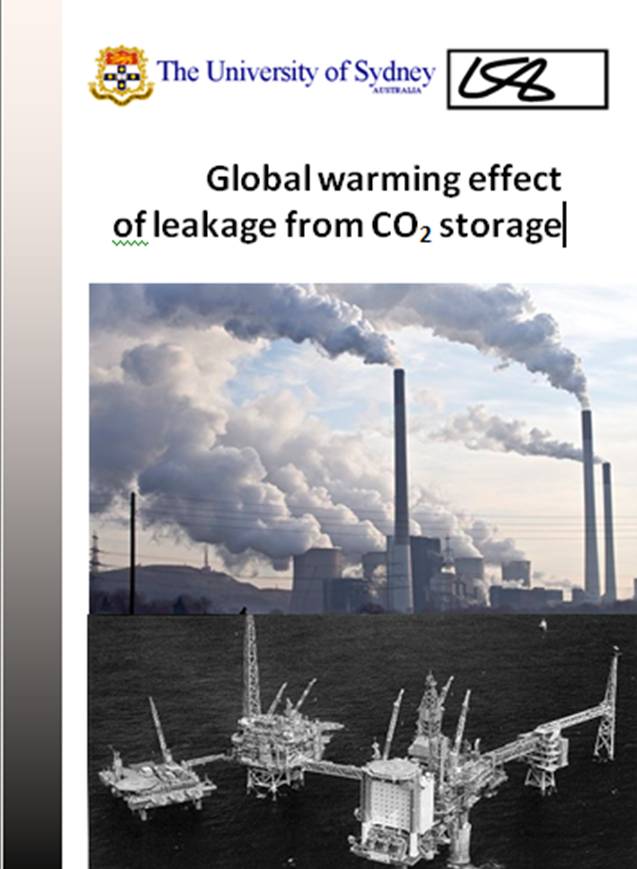 |
Global warming effect of leakage from CO2 storage
Most assessments of carbon capture and storage (CCS) characterise technologies in terms of annual or cumulative avoided emissions. However, the ultimate purpose of CCS is not the abatement of emissions, but the avoidance of damages to be expected from climate change. Two CO2 storage and monitoring projects have injected so far more than 5 Mt CO2 into a depleted oil field and more than 10 Mt CO2 into a deep saline formation without detectable leakage. However, technology assessments mention the possibility of rapid leakage paths, for example in form of failed wells. This report presents a thorough analysis of the relationship between CO2 leakage and global temperature change.
|
 |
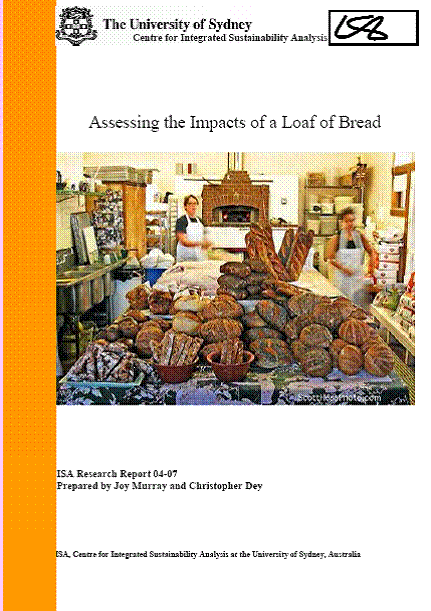 |
Assessing the impacts of a loaf of bread
This paper provides detailed information about on-site and supply chain costs of producing a loaf of bread, in terms of indicators across the social, economic and environmental bottom lines. Both on-site and supply-chain viewpoints help to tell a story. Both are necessary components of the true cost of a loaf of bread. But the real decision about what to do with this information ultimately rests with people. What an integrated sustainability analysis of bread can offer are metrics and results, underpinned by a transparent philosophy, that can lay bare the intricacies of an interdependent and infinite supply chain. |
 |
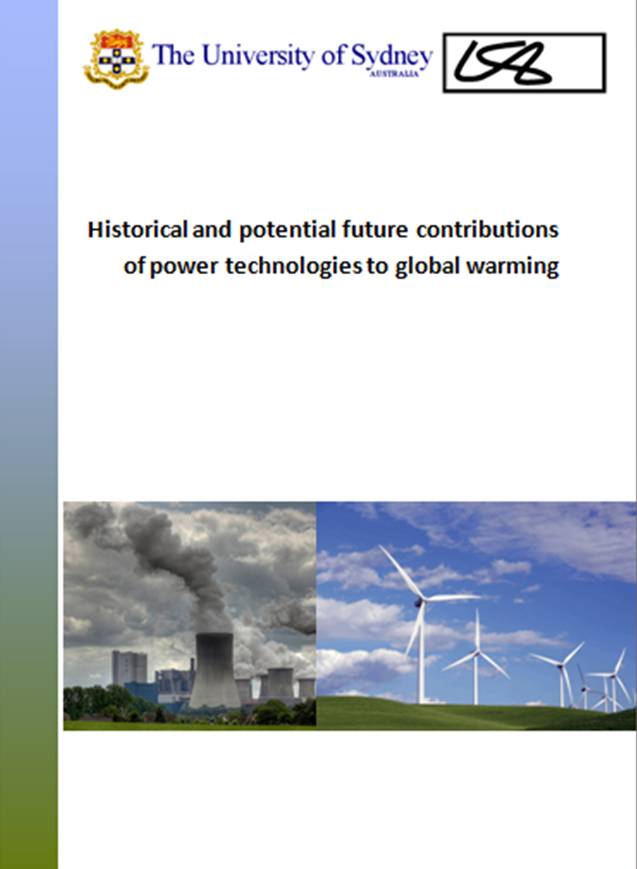 |
Historical and potential future contributions of power technologies to global warming
Using the mathematical formalism of the Brazilian Proposal to the IPCC, we analyse eight power technologies with regard to their past and potential future contributions to global warming. Taking into account detailed bottom-up technology characteristics we define the mitigation potential of each technology in terms of avoided temperature increase by comparing a coal-only reference scenario and an alternative low-carbon scenario. Historically (1900-2006), hydro, nuclear, and gas-fired power have achieved the largest mitigation. This ranking is partly due to the magnitudes at which these technologies are deployed, but in part also due to their deployment histories. Similarly, potential future (2009-2100) contributions are influenced by the magnitude of future capacity as well as temporal deployment profiles. A general conclusion is that early technology deployment matters. We conclusively show that avoided temperature increase is a better proxy for comparing technologies with regard to their impact on climate change, and that comparisons based on annual or even cumulative emissions may be misleading. Therefore, not only comparisons between countries, but also comparisons between technologies should be undertaken on the basis of avoided temperature increase rather than on the basis of annual emissions as is practice today.
|
 |
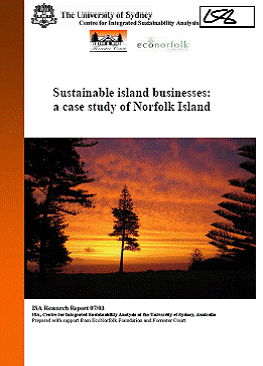 |
Sustainable island businesses: a case study of Norfolk Island
Conventional measures aimed at tackling the energy and waste issues of island communities focus on technological solutions, such as the introduction of renewable energy sources. There exists a history of technology implementations on small islands that have failed because of a lack of continuing skills and financial resources needed for ongoing operation and maintenance. Despite these experiences, what has received little attention so far are measures aimed at achieving island-friendly solutions by reducing their material metabolism, for example by recycling and re-use. The two case studies presented in this work show that conservation, efficiency and reductions of the overall material metabolism of economic activity can be as effective as purely technologically-driven changes. Both case studies demonstrate exceptional sustainability performance in terms of material flow, and greenhouse gas emissions. The income growth scenarios show that from a sustainability point of view increasing tourist yield rather than tourist numbers is preferable for coping with price hikes and a finite resource base, and is also more likely to keep within bounds the strain on the islands people and infrastructure. |
 |
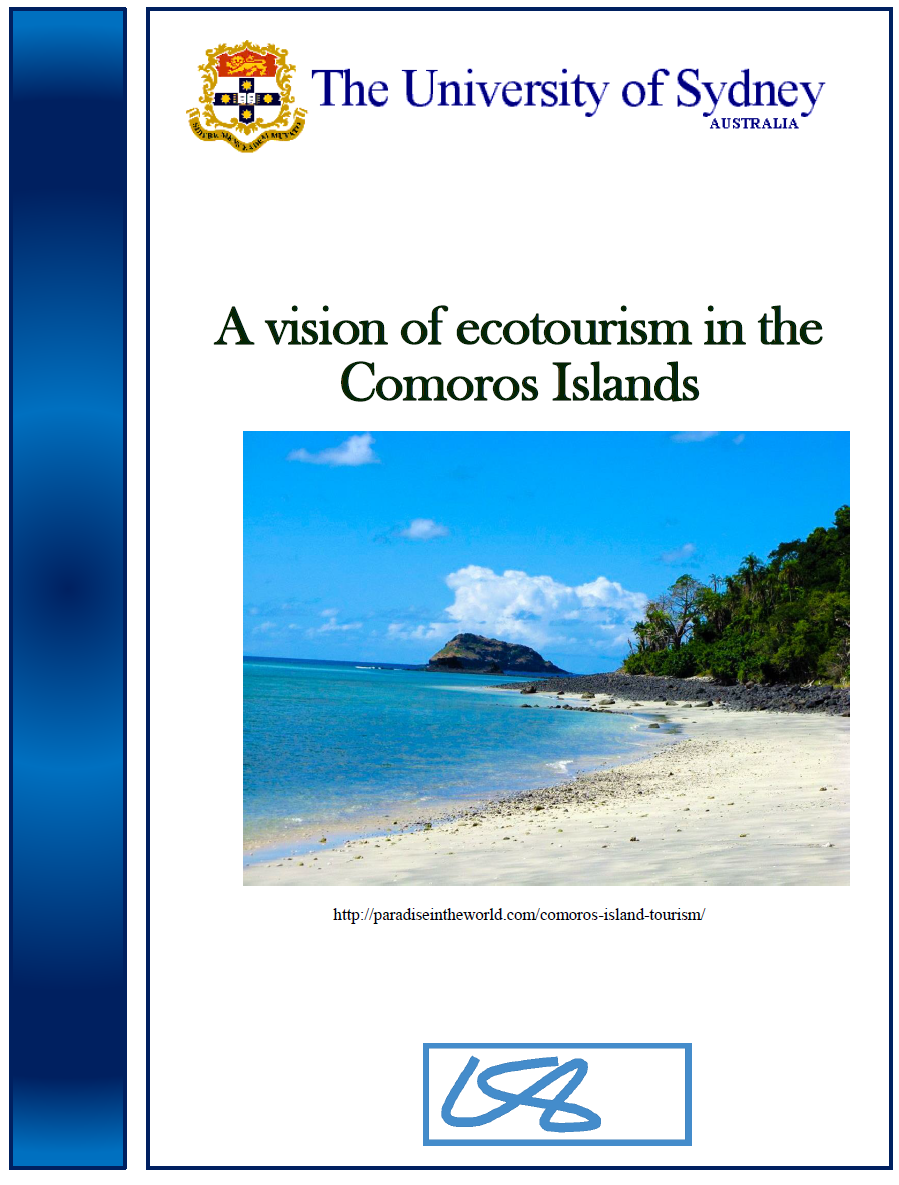 |
A vision of ecotourism in the Comoros Islands
Despite their significant potential for ecotourism, the Comoros islands are thoroughly ignored in the international literature on the topic. In this paper we offer the first comprehensive assessment of the Comoros in terms of their socio-economic, demographic, geographic and political setting, and how this setting translates into opportunities and barriers for ecotourism. We present four sites that provide evidence for a realistic ecotourism vision. Notwithstanding the potential of these sites for generating tourist income, we assess a number of critical political and infrastructure challenges that will have to be overcome in order to turn the vision into reality. |
 |
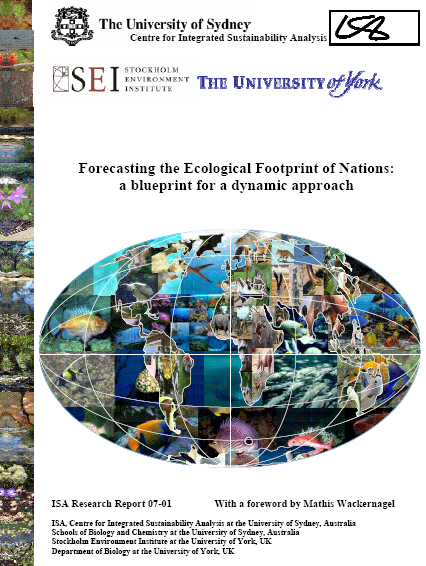 |
Forecasting the Ecological Footprint of Nations - a blueprint for a dynamic approach
This report provides the theoretical base and an example for expanding the static Ecological Footprint accounting method into a dynamic forecasting framework which is forward looking to 2050, incorporating biodiversity amongst other factors, into a causal network of driving forces, and taking into account globalised trade with its complex supply chains. This world-first Dynamic Ecological Footprint connects the original Ecological Footprint method with some modifications that were anchored at different points of the causal network, such as land use and disturbance, species diversity, and pollution. It thus demonstrates an effective and elegant means for unifying a range of methodologies and objectives into on framework while retaining the research question and metric of the original approach.
|
 |
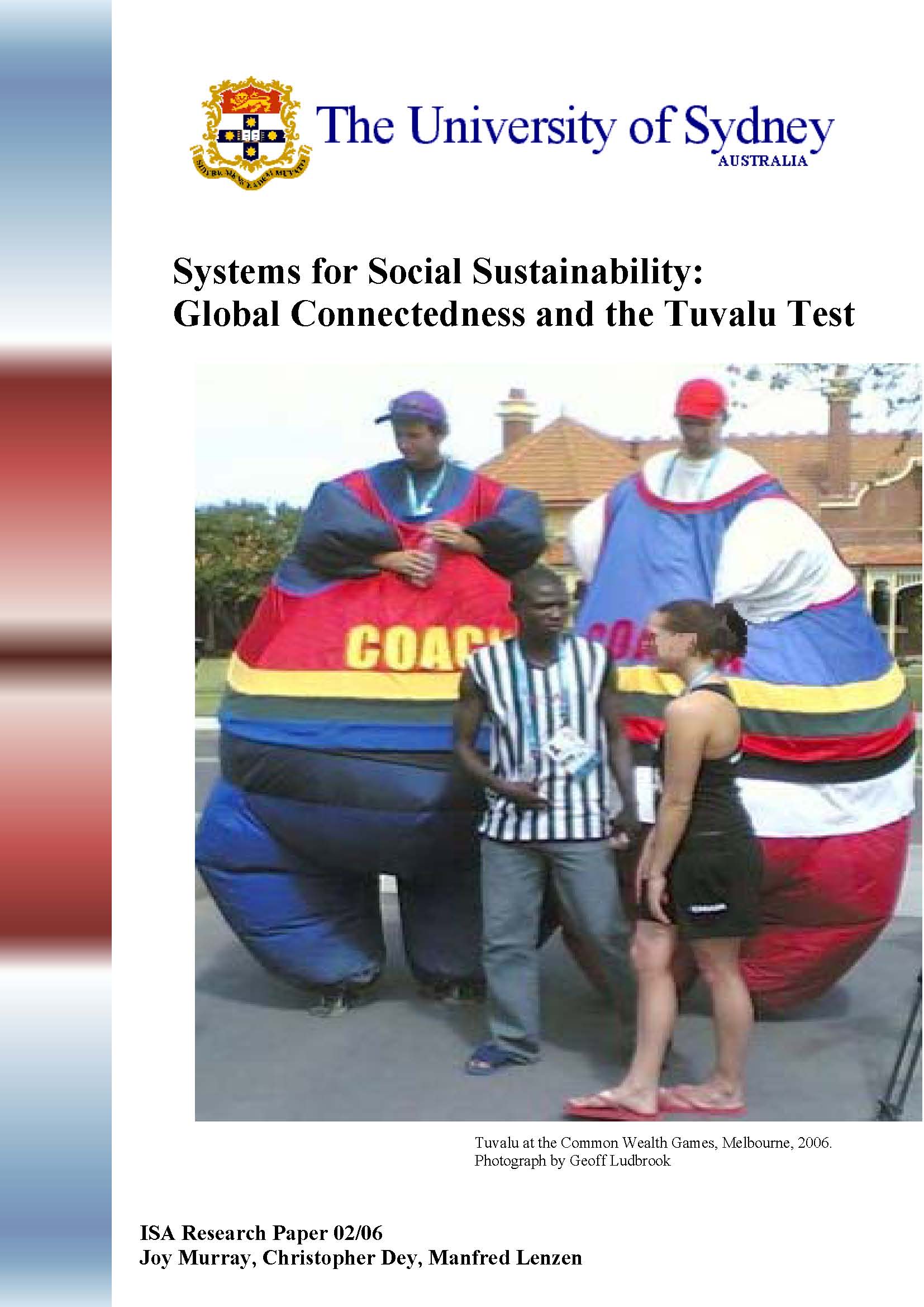 |
Systems for Social Sustainability: Global Connectedness and the Tuvalu Test
We discuss the social dimension of the TBL as the social impact of (an organisation) doing
business. Acknowledging the interconnectivity of social, environmental, and economic impacts
on a local scale we recognise that everything we do together on this planet is connected through
time and space in a seamless web of interactions. Moreover through this interdependency of
living system and environment our actions are bound by something we refer to as human ethics.
This brings us to the idea that the social dimension of TBL, which seeks ethical solutions to local
social dilemmas is striving towards something that we call social sustainability and in some way
is contributing to an ethical future for living systems. Hence the discussion moves from the
social bottom line of an organisation, or workplace, into the notion of social sustainability and
society as a whole because all of society is interlinked. |
 |
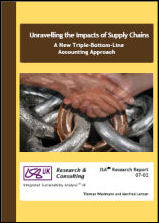 |
Unravelling the Impacts of Supply Chains
The research question of this report is "How can corporate sustainability performance be quantified and compared in practice, whilst taking into account the responsibility sharing nature of trading and avoiding double-counting of impacts?". The report a) describes the analytical approach to measure the indirect impacts of a comprehensive Triple Bottom Line account of a producing entity, b) presents a quantitative concept of shared responsibility as a solution to assigning responsibility to both producers and consumers, in a mutually exclusive and collectively exhaustive way, and c) demonstrates practical applications in examples of quantification of indirect impacts, supply chain contributions and shared responsibility.
|
 |
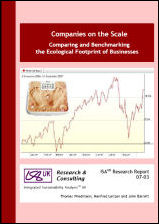 |
Companies on the Scale: Ecological Footprint of Businesses
Calculating the Ecological Footprint of a company ought to fulfil certain requirements. It has to take into account the direct Footprint impacts such as direct land appropriation and emissions from vehicles and premises. And it also must take account of indirect impacts that are embodied in all the purchases the company makes. As companies and individual (final) consumers are not at the same place in the life-cycle of production and consumption, different calculations and conversion factors have to be applied, otherwise there would be double-counting and non-comparability of Footprints. This report presents an extended input-output approach to calculate Footprints of companies that are truly comparable and discusses the implications for sustainable chain management and sector sustainability.
|
 |
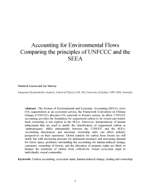 |
Accounting for Environmental Flows - Comparing the principles of UNFCCC and the SEEA
The System of Environmental and Economic Accounting (SEEA) views CO2 sequestration as an ecosystem service, the Framework Convention on Climate Change (UNFCCC) allocates CO2 removals to forestry sectors. In effect, UNFCCC accounting provides the foundation for sequestered carbon to be owned and traded. Such ownership is not explicit in the SEEA. Moreover, interpretations of human inducement that are used to justify the classification of sequestered carbon as ‘anthropogenic’ differ substantially between the UNFCCC and the SEEA. Accounting dissonances and uncertain ownership rules can affect industry perspectives on their operations. Global markets for carbon from forests are still small, but with increasing pressure for abatement measures and increasing demand for forest space, problems surrounding the accounting for human-induced change, customary ownership of forests, and the allocation of property rights are likely to hamper the transition of carbon from collectively owned ecosystem input to individually owned commodity. |
 |
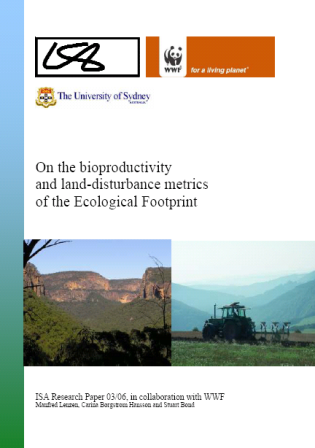 |
On the bioproductivity and land disturbance metrics of the Ecological Footprint
Since the Ecological Footprint was invented, research groups around the world have adapted the concept to their particular circumstances.
In particular, researchers have used different metrics that pertain to different research questions.
For example, while the metric used by the organisers of the Global Footprint Network expresses bioproductivity requirements in global hectares, an Australian approach examines land disturbance in local hectares.
This report - co-authored by researchers from ISA and WWF - follows up on discussions at the Ecological Footprint Forum in Italy (2006).
It highlights a number of situations, where managing for bioproductivity alone may lead to counter-productive incentives.
We conclude that in these cases, the bioproductivity metric needs to be complemented with additional information such as on land disturbance and biodiversity.
|
 |
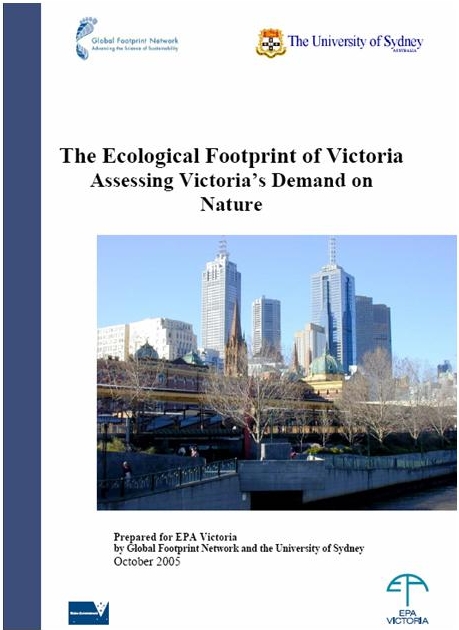 |
The Ecological Footprint of Victoria Assessing Victoria's Demand on Nature
EPA Victoria commissioned Global Footprint Network and the University of Sydney to
jointly produce a robust assessment of the State of Victorias Ecological Footprint. The
purpose of this study was two-fold:
1. Calculate Victorias Footprint using two different methods;
2. Assess the relative strengths and weaknesses of both approaches, with the ultimate
goal of making the two methods compatible and consistent.
|
 |
More reports:
Lenzen M,
Individual responsibility and climate change.
Lenzen M,
Nature, preparation and use of water accounts in Australia, Cooperative Research Centre for Catchment Hydrology, Technical Report 04/2, Monash University, Melbourne, Australia, 2004.
Lenzen M and Wood R,
Ecological Footprint and Triple Bottom Line Report for Wollongong Council and the Wollongong Population, commissioned by Wollongong Council, Wollongong, Australia, 2003.
Foran B, Lenzen M, Dey C and Bilek M,
A Novel TBL Initiative, ISA Research Paper 01-02.
Lenzen M and Dey C,
The Ecological Footprint of Canberra, commissioned by the Australian Capital Territory's Office of Sustainability, 2004.
Lenzen M, Lundie S, Bransgrove G, Charet L, and Sack F,
A novel Ecological Footprint and an example , ISA Research Paper 02-02.
Davies O, and Murray J, Literacy Learning On Line: An evaluation of the 2001 Log on to Literacy Program, report to the NSW Department of Education and Training, Training and Development Directorate, Sydney, 2002.
Lenzen M,
The influence of lifestyles on environmental pressure, commissioned by the Australian Bureau of Statistics for its 2002 Year Book Australia.
Green B, Bigum C, Durrant C, Honan E, Lankshear C, Morgan W, Murray J, Snyder I, and Wilde M, Digital Rhetorics. Literacies and Technologies in Education - Current Practices and Future Directions, commissioned by Department of Employment Education Training and Youth Affairs, Commonwealth of Australia, 1997.
|






















